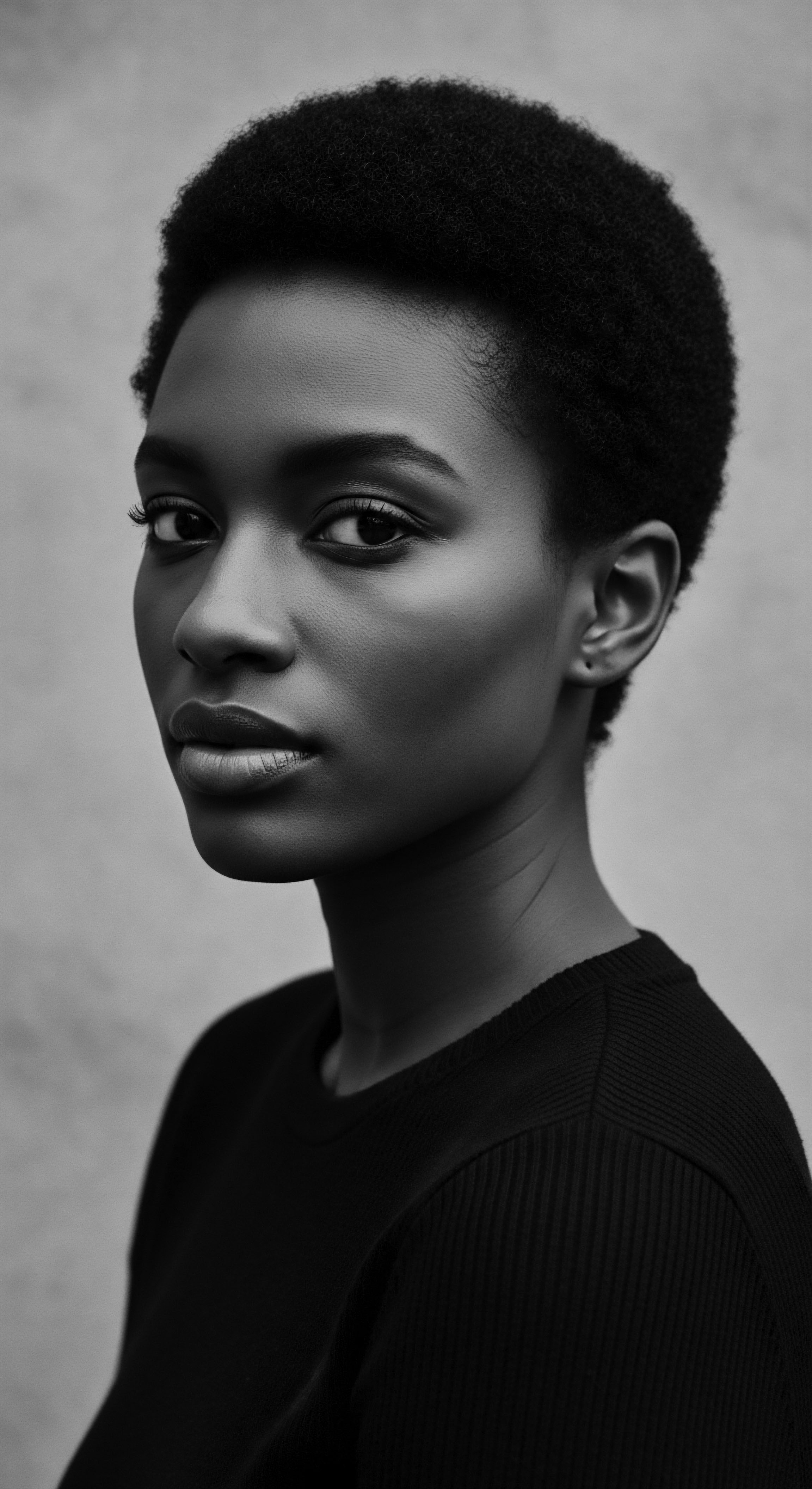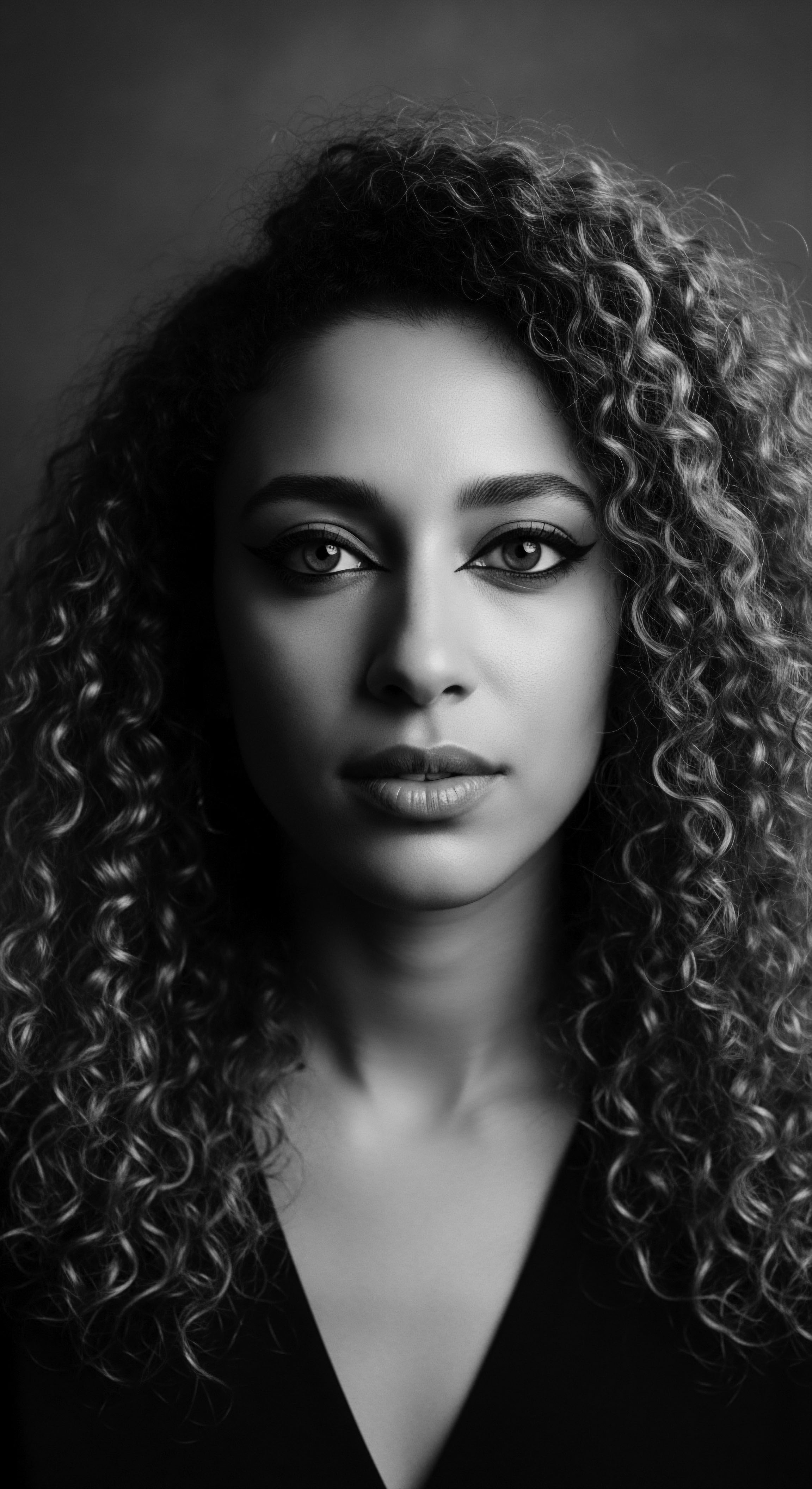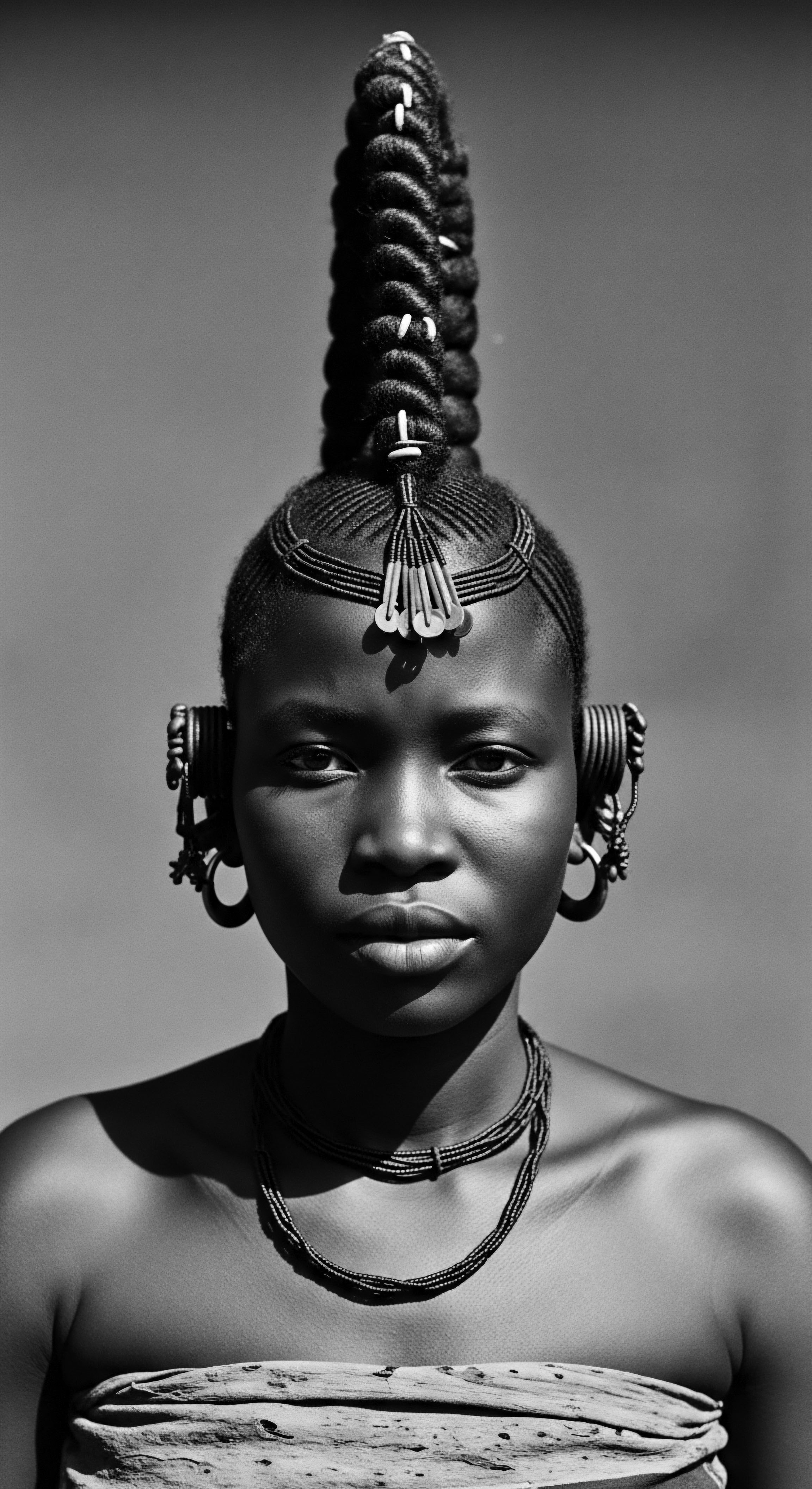
Fundamentals
The very concept of Kibe reaches beyond a simple descriptor of hair. It stands as a profound designation, a foundational explanation of the deep, intrinsic nature of textured hair, particularly as it exists within Black and mixed-race heritage. To comprehend Kibe is to begin an exploration into the very spirit of the strand, recognizing its unique biological endowments and the rich historical context that has shaped its expression.
At its most accessible, Kibe represents the innate, core characteristics that differentiate textured hair. It encompasses the distinct patterns of coiling, the varied diameters along each strand, and the inherent resilience woven into its structure. This resilience, often a source of both wonder and misunderstanding, allows textured hair to adapt to diverse climates and withstand environmental fluctuations. Understanding Kibe from this fundamental vantage point means appreciating the hair’s natural inclination, its predisposition to certain forms of care, and its vibrant response to nurturing touch.
Consider Kibe as the initial genetic whisper, the elemental code that dictates the unique way a textured strand will unfurl from the follicle. It is the unwritten instruction manual embedded within each hair, guiding its growth trajectory and influencing its innate strength. This intrinsic essence sets the stage for how the hair will interact with moisture, react to manipulation, and respond to the specific ingredients that have been passed down through generations of care.
Kibe is the fundamental, intrinsic nature of textured hair, representing its unique biological blueprint and inherent resilience from the very follicle.
This initial understanding of Kibe offers a gateway into a deeper appreciation of textured hair’s capabilities. It moves beyond superficial observations of curl pattern, inviting an inquiry into the underlying biological architecture that enables such diverse and complex forms. This elemental knowledge is the bedrock upon which all further comprehension of textured hair care and heritage stands. It compels us to see each strand not merely as a decorative element, but as a living testament to an ancient, enduring biological wisdom.
The historical perspective reveals that even in ancient times, communities understood this fundamental Kibe, developing practices that honored the hair’s intrinsic needs. These ancestral insights, though perhaps not articulated in scientific terms, reflected an intuitive grasp of what made textured hair thrive. They recognized its thirst for specific emollients, its preference for gentle detangling, and its capacity for protective styling.
This rudimentary understanding formed the initial layer of a rich heritage of hair knowledge, passed from elder to youth, generation after generation. The very patterns of life, deeply intertwined with the hair’s cycle, informed these foundational customs.

Intermediate
Moving into a more intermediate understanding, Kibe expands from a simple explanation of intrinsic characteristics into a dynamic concept of Ancestral Memory and inherited wisdom. This dimension of Kibe speaks to how the historical experiences of textured hair, spanning millennia and continents, have profoundly shaped its present-day characteristics and how we interact with it. It encompasses the nuanced interplay between biophysical traits and the cultural legacies of care that have evolved alongside these strands.
Kibe, at this level, interprets the hair not only as a biological entity but as a living archive, carrying echoes of countless hands that have touched, braided, and adorned it across time. This perspective recognizes that the hair’s responsiveness to certain ingredients or techniques might be partly attributable to a long history of generational exposure and adaptation. It is the subtle, inherited inclination for particular nutrients or methods of handling that have proven effective for this hair type through varied environmental and social conditions. The resilience of textured hair, for instance, transcends mere physical strength; it mirrors the enduring spirit of the communities it crowns, having navigated periods of both celebration and profound challenge.
Consider the deep, enduring cultural significance hair holds across the African diaspora. This is not merely an aesthetic preference; it is a manifestation of Kibe—the collective memory of hair as a spiritual conduit, a marker of identity, status, and resistance. Hair became a visual language, capable of conveying profound messages, even when spoken words were silenced. The intricate patterns of braids, the deliberate choice of adornments, and the very act of maintaining hair’s health were acts of self-determination, preserving a sense of self and community against forces of erasure.
Kibe represents the ancestral memory embedded within textured strands, a living archive of historical experiences, cultural practices, and inherited wisdom.
This intermediate stage of Kibe understanding also clarifies the long-standing traditional practices found within Black and mixed-race hair care. These rituals are not arbitrary; they are deeply informed by generations of accumulated knowledge, often predating modern scientific explanation. The prolonged use of specific plant-based oils and butters, for example, for sealing moisture and promoting pliability, reflects an intuitive comprehension of textured hair’s unique lipid needs—a Kibe-guided response. These traditional formulations, passed down through oral histories and embodied practice, inherently address the hair’s inherent structure and its propensity for dryness due.
The historical understanding of Kibe’s influence is particularly evident in how certain care traditions have persisted across geographical divides. Despite forced migration and displacement, the core tenets of textured hair care often traveled with their people, adapting yet retaining their essential purpose. These traditions spoke to a shared, ancestral knowledge of Kibe, a recognition that the hair, despite new environments, retained its fundamental requirements.
For instance, the emphasis on communal hair grooming, often a site of storytelling and knowledge transfer, served to reinforce this inherited wisdom, ensuring that the Kibe of each generation was understood and nurtured. This continuity, even in adversity, is a powerful testament to the enduring presence of Kibe.
The adaptability of Kibe also manifests in how new techniques and ingredients were integrated over time, always filtered through the lens of what truly served the textured strand. This discerning process ensured that innovations were not adopted blindly but rather thoughtfully applied, enhancing traditional methods without diminishing the hair’s intrinsic nature. This dynamic exchange between continuity and measured evolution forms a key aspect of Kibe at this intermediate level.
One might delineate the various aspects of Kibe at this stage through its manifestations:
- Biophysical Adaptation ❉ The hair’s inherent capacity to adjust to varying climates and external stressors, learned and passed down over generations.
- Cultural Expression ❉ The use of hair as a medium for conveying identity, social status, spiritual beliefs, and resistance, a visual representation of community narratives.
- Ancestral Care Rituals ❉ The specific techniques and natural ingredients utilized through history, refined by countless hands and informed by the hair’s unique requirements.
- Communal Nurturing ❉ The practice of hair care as a shared, intergenerational activity, reinforcing bonds and transmitting knowledge.

Academic
At an academic level, the concept of Kibe transcends anecdotal understanding, emerging as a sophisticated construct that interweaves the biophysical complexities of textured hair with its profound socio-cultural, historical, and even epigenetic implications. Here, Kibe is defined as the epigenetic legacy and biophysical resilience encoded within textured hair follicles, reflecting centuries of adaptive evolution and culturally informed care practices. This delineation offers an expert-level examination, requiring a rigorous analysis of interconnected incidences across biological, anthropological, and historical fields. It demands a deep comprehension of how external forces, alongside inherited predispositions, have shaped the Kibe of textured hair, yielding a unique biological memory that informs its growth, structure, and responsiveness.
From a scientific lens, Kibe encompasses the distinct molecular architecture of textured hair. Unlike straight or wavy hair, the highly elliptical cross-section of textured strands, coupled with the uneven distribution of keratin and unique disulfide bond arrangements, creates inherent points of torsional stress and fragility, paradoxically alongside immense potential for volume and elasticity. The Kibe, in this context, describes the hair’s pre-programmed inclination to form these tight, helical coils and the specific challenges and advantages that arise from this configuration.
The lipid profile of textured hair, often possessing a lower natural oil distribution along the shaft due to the convoluted path of the strand, requires a particular approach to moisture retention—a biological imperative deeply ingrained in Kibe. This inherent demand for specific lipid and protein replenishment is not merely a modern discovery; it is a biological truth that ancestral practices intuitively addressed.
Expanding on its socio-cultural dimension, Kibe represents the deep semiotics of textured hair within Black and mixed-race communities. Historically, hair served as a potent symbol of one’s lineage, spiritual connection, and social standing in many African societies. The intricate coiffures of pre-colonial West African cultures, for example, were not simply decorative; they conveyed marital status, age, community allegiance, and even spiritual protection. The act of styling hair became a ritualized process, reinforcing communal bonds and transmitting cultural narratives.
This ancestral understanding of hair as a sacred, communicative medium is a foundational aspect of Kibe, demonstrating its role as a vessel of collective identity. The preservation of these practices, even under immense duress during the transatlantic slave trade, speaks to the profound resilience of Kibe as a cultural anchor.
The academic interpretation of Kibe integrates biophysical complexities with socio-cultural, historical, and epigenetic influences, defining it as the inherent biological memory and adaptive resilience of textured hair.
Moreover, the epigenetic aspect of Kibe offers a particularly compelling area for academic exploration. While the fundamental genetic code dictates hair type, epigenetics examines how environmental factors and lived experiences can influence gene expression without altering the underlying DNA sequence. One might propose that centuries of adaptation, including dietary changes, climate shifts, and the profound physiological and psychological impacts of slavery and systemic discrimination, have left subtle epigenetic imprints on textured hair. These imprints could manifest as heightened sensitivities, altered protein synthesis, or even a predisposition towards certain forms of fragility or strength.
This does not imply genetic mutation but rather a historical conditioning that affects how the Kibe expresses itself across generations. For example, the stress of limited resources during enslavement periods might have led to generations whose hair, while still textured, exhibited different characteristics that adapted to those constraints, revealing a profound biological wisdom passed down, not through explicit genetic change, but through how genes are expressed .
Consider the profound, enduring knowledge regarding the properties of specific natural emollients within certain West African communities, such as the consistent application of shea butter (Vitellaria paradoxa) for hair and skin. Traditional uses of shea butter have been documented for centuries across the Sahel and Sudan regions, revered for its conditioning and protective qualities. The sustained reliance on this particular ingredient highlights an inherited wisdom, a deep-seated comprehension of textured hair’s biophysical Kibe, its inherent need for specific fatty acid profiles to maintain pliability and prevent breakage in challenging climates. This is a knowledge transmitted not merely as folklore, but as a living, applied science.
Dr. Ute G. G. W.
Wittig (2005) notes in her research on African ethnobotany that traditional practices often demonstrate an sophisticated, empirical understanding of botanical properties that modern science is only now fully quantifying. The continuous, multi-generational application of shea butter to textured hair in West African societies, for example, illustrates a practical, ancestral attunement to the hair’s lipid requirements and its inherent propensity for moisture loss, a tangible manifestation of Kibe guiding effective care (Wittig, 2005). The hair’s capacity to absorb and benefit from these specific lipids is part of its Kibe, developed over long evolutionary and cultural engagement.
| Traditional Application Daily application to scalp and hair strands for softening and protection. |
| Biophysical Kibe Connection (Modern Scientific Link) The high concentration of oleic acid and stearic acid in shea butter provides excellent emollient properties, mimicking natural sebum and addressing the inherent moisture challenges of textured hair's structure. |
| Traditional Application Used as a pre-treatment before braiding or styling. |
| Biophysical Kibe Connection (Modern Scientific Link) Reduces friction and improves elasticity, protecting the hair's cuticle from mechanical damage during manipulation, thereby honoring the Kibe's structural vulnerabilities. |
| Traditional Application Integrated into communal hair grooming rituals. |
| Biophysical Kibe Connection (Modern Scientific Link) Reinforces the social transmission of knowledge about the hair's unique needs, embedding the practical application of Kibe-informed care within community memory. |
| Traditional Application This ancient practice exemplifies how ancestral wisdom intuitively addressed the unique Kibe of textured hair, ensuring its health and vitality across generations. |
The resilience inherent in Kibe is also evident in how textured hair, despite facing historical attempts at suppression and assimilation, has consistently reasserted its presence and power. The natural hair movement, a global phenomenon, does not merely represent a trend; it is a reclamation of Kibe. It signals a collective remembering, a reaffirmation of the intrinsic beauty and strength of textured strands, and a rejection of Eurocentric beauty standards.
This movement draws upon and revitalizes ancient practices, demonstrating how the Kibe endures as a source of self-acceptance and cultural pride. The re-adoption of traditional ingredients and protective styles is a powerful testament to the hair’s biological memory, its predisposition to thrive under care methods that honor its inherent structure and needs.
Furthermore, understanding Kibe requires an interdisciplinary approach, drawing from dermatology, genetics, anthropology, and sociology. Hair biologists contribute insights into the unique follicular morphology and biochemical composition that dictate curl pattern and strength. Anthropologists illuminate the cultural meanings and rituals associated with hair across various African and diasporic societies. Historians trace the evolution of hair practices and their connection to broader social movements.
Sociologists examine the impact of hair on identity formation, self-esteem, and social perception. A holistic comprehension of Kibe demands the synthesis of these diverse perspectives, revealing its true complexity as a deeply ingrained aspect of both individual and collective being.
The academic investigation into Kibe also examines instances where the recognition of textured hair’s unique attributes—its Kibe—was deliberately obscured or denigrated. During colonial periods and eras of enslavement, efforts to impose European hair standards were not simply aesthetic preferences; they were attempts to sever a vital connection to cultural heritage and to undermine the inherent Kibe. Yet, the persistence of traditional hair care practices, often performed in secrecy, underscores the indomitable nature of this biological and cultural memory.
These acts of quiet resistance served to preserve not just the physical health of the hair, but the spiritual and communal Kibe that resided within those strands. The capacity for these hair care traditions to survive and re-emerge centuries later is a powerful testament to Kibe’s enduring strength.
In conclusion, the academic understanding of Kibe provides a comprehensive interpretation, moving beyond basic observation to reveal a multi-layered phenomenon. It serves as a framework for analyzing how textured hair, through its unique biophysical properties and its embedded cultural memory, continues to tell a story of resilience, adaptation, and profound heritage. This deeper dive invites scholars, practitioners, and individuals alike to appreciate the hair not just for its appearance, but for the millennia of wisdom and strength it embodies.

Reflection on the Heritage of Kibe
The enduring significance of Kibe, as we have explored it, extends far beyond mere scientific or historical classification. It stands as a profound meditation on textured hair, its heritage, and its care—presented as a living, breathing archive. Kibe is the silent, yet eloquent, storyteller etched into every coil and curve, carrying within it the echoes of ancestral hands, the whispered wisdom of generations, and the unbreakable spirit of those who have worn their hair as a crown of identity. The journey of understanding Kibe, therefore, is not a simple intellectual exercise; it is an intimate re-connection with a profound legacy.
This concept reminds us that hair care, for Black and mixed-race individuals, is often an act of sacred remembrance. Each detangling session, every application of natural oils, and each protective style chosen carries a lineage. It is an affirmation of practices that nourished hair in ancient villages, sustained it through periods of immense adversity, and celebrated it as a vibrant expression of self in the face of societal pressures. Kibe compels us to view our textured strands as more than just protein filaments; they are threads of a vast, interconnected ancestral tapestry.
The beauty and the strength of Kibe truly shine in its capacity for resilience. Textured hair has witnessed epochal shifts, from the communal styling rituals of pre-colonial Africa to its weaponization during eras of subjugation, and its triumphant reclamation in contemporary movements. Through it all, the fundamental Kibe—the hair’s inherent capacity to thrive when understood and respected—has persisted.
It has adapted, changed, and yet maintained its distinct essence, embodying the adaptive spirit of a people. This unbroken lineage of care, resilience, and identity speaks volumes without uttering a single word.
Our ongoing relationship with textured hair is a conversation with history, a dialogue with our very roots. By honoring the Kibe, by seeking to understand its biological needs through the lens of ancestral wisdom, we are not simply tending to our hair; we are nurturing a powerful connection to our past, empowering our present, and shaping a future where the diverse beauty of textured hair is unequivocally celebrated. Kibe offers a profound realization ❉ the heritage of our hair is not a forgotten relic, but a living, breathing part of who we are, continuously reminding us of the strength, beauty, and wisdom woven into every strand.

References
- Byrd, Ayana D. and Lori L. Tharps. Hair Story ❉ Untangling the Roots of Black Hair in America. St. Martin’s Griffin, 2014.
- Childs, G. T. A Grammar of Mankon ❉ A Bantu Language of Cameroon. Mouton de Gruyter, 2003.
- Gates, Henry Louis Jr. The Signifying Monkey ❉ A Theory of Afro-American Literary Criticism. Oxford University Press, 1988.
- hooks, bell. Sisters of the Yam ❉ Black Women and Self-Recovery. South End Press, 2005.
- Opoku, Abena. African Body Adornment. Pallas Athene, 2018.
- Pittman, R. L. Applied Linguistics for Language Teaching. John Benjamins Publishing Company, 1984.
- Thompson, Robert Farris. Flash of the Spirit ❉ African and Afro-American Art and Philosophy. Vintage Books, 1984.
- Wittig, Ute G. G. W. Ethnobotany of African Shea Butter. Cuvillier Verlag, 2005.
